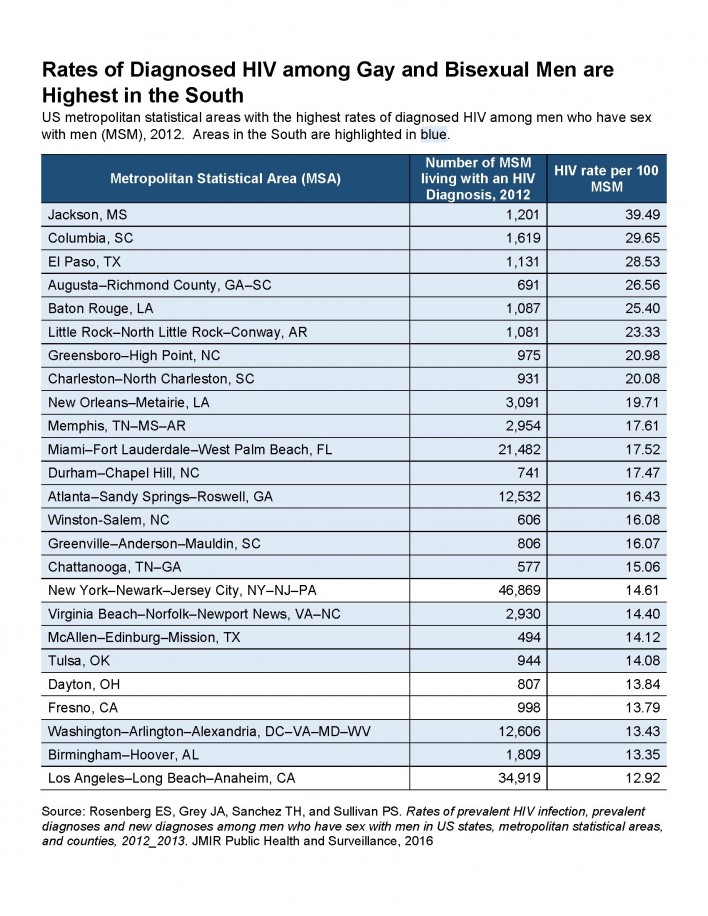For the first time, researchers have broken down HIV prevalence figures among men who have sex with men (MSM) by city and state, highlighting a disproportionate burden in the South. Publishing their report in JMIR Public Health and Surveillance, researchers culled information form AIDSVu.org and the Centers for Disease Control and Prevention (CDC) and considered the number of MSM living with the virus in 2012, those who were diagnosed by that year and those who were newly diagnosed in 2013. They broke down these figures by U.S. states, by so-called metropolitan statistical areas (MSAs) and by counties.
The researchers based their estimates of HIV prevalence (the number of people living with HIV), HIV-diagnosed prevalence and the number of MSM diagnosed with HIV annually on estimates of the number of MSM living in every U.S. county according to recently published figures based on data from the National Health and Nutrition Examination Survey and the American Community Survey.
According to the new study authors’ calculations, out of an estimated 4.45 million MSM in the United States, 666,900, or 15 percent, are estimated to be HIV positive. In 2013, an estimated 0.7 percent of the MSM population was diagnosed with the virus.
MSM living in the South are especially hard hit by HIV. Of the 25 MSAs with the highest rates of diagnosed HIV among MSM, all but four were in the South. The top six each had HIV-diagnosed prevalence rates higher than 25 percent among MSM: Jackson, Mississippi (1,201 MSM, or 39.39 percent); Columbia, South Carolina (1,619, or 29.65 percent); El Paso, Texas (1,131, or 28.53 percent); Augusta–Richmond County, which is in both Georgia and South Carolina (691, or 26.56 percent); and Baton Rouge, Louisiana (1,087, or 25.4 percent).
Out of these top 25 MSAs, only five had more than 3,100 MSM living with diagnosed HIV, including: Miami–Fort Lauderdale–West Palm Beach, Florida (21,482 MSM, or 17.52 percent); Atlanta–Sandy Springs–Roswell, Georgia (12,532, or 16.43 percent); New York City–Newark–Jersey City, which includes portions of New York State, New Jersey and Pennsylvania (46,869 HIV-diagnosed MSM, for a rate of 14.61 percent, the first non-Southern MSA on the prevalence rate list, at 17th place); Washington–Arlington–Alexandria, in the District of Columbia, Virginia, Maryland and West Virginia (12,606, or 13.43 percent); and Los Angeles–Long Beach–Anaheim, California (34,919, or 12.92 percent).
Outside of the New York City and Los Angeles areas, Dayton, Ohio (807 MSM, or 13.84 percent), and Fresno, California (998, or 13.79 percent), were the only other non-Southern MSAs on the list of those with the 25 highest diagnosed-HIV rates among MSM.
As for states (which includes the District of Columbia), Georgia’s figures are especially troubling. It is the only state in the nation to have a greater than 15 percent rate of diagnosed HIV among MSM as well as more than 15,000 cases (24,101, or 18.51 percent).
In eight states, all in the South, more than 0.9 percent of the MSM population is diagnosed with HIV each year, including Louisiana (2.24 percent), Mississippi (2.18 percent), Georgia (1.59 percent), South Carolina (1.56 percent), Alabama (1.29 percent), Arkansas (1.17 percent), the District of Columbia (1.06 percent) and Florida (0.93 percent).

CDC/Emory University
“These refined results are an additional tool for regional and local public health action and provide further evidence for the need to prioritize HIV prevention efforts for MSM and particularly for MSM living in the South,” the study’s head, Eli Rosenberg, PhD, assistant professor of epidemiology at Emory University’s Rollins School of Public Health, said in a press release.
“By pinpointing where HIV strikes the hardest, we have a key piece of the puzzle highlighting the largest disparities within states and the South,” Jonathan Mermin, MD, MPH, director of the CDC’s National Center for HIV/AIDS, Viral Hepatitis, STD, and TB Prevention, said in the same release. “We hope these data empower local public health officials, community-based organizations and everyone fighting HIV to bring resources to the gay and bisexual men who need them the most.”
To read the press release, click here.

CDC/Emory University







1 Comment
1 Comment